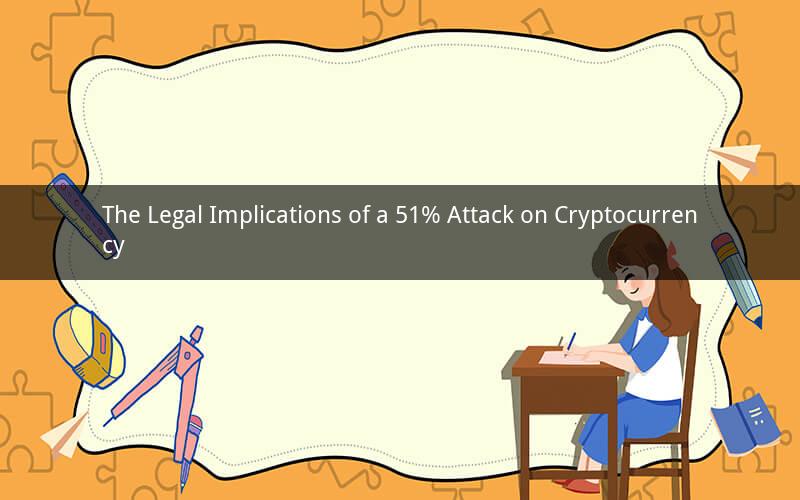
Introduction:
A 51% attack on a cryptocurrency refers to a situation where a single entity or a group of entities gain control over more than half of the network's mining power. This gives them the ability to manipulate the blockchain, potentially leading to double-spending, halving the block reward, or even causing the network to halt. In this article, we will explore the legality of a 51% attack on cryptocurrency, discussing the potential consequences and the legal frameworks that may apply.
1. Understanding a 51% Attack
A 51% attack occurs when an attacker has more than half of the total computational power of a cryptocurrency network. This gives them the ability to control the consensus mechanism, which is responsible for validating transactions and adding new blocks to the blockchain. By doing so, the attacker can manipulate the network and disrupt its operations.
2. Legal Implications
The legality of a 51% attack on cryptocurrency varies depending on the jurisdiction. However, there are several potential legal implications that can arise from such an attack.
a. Fraud and Manipulation:
A 51% attack can be considered fraud, as it involves manipulating the blockchain to deceive other users. Fraudulent activities can lead to civil lawsuits, where victims can seek damages for their losses. In some cases, criminal charges may also be filed, depending on the severity of the attack and the jurisdiction.
b. Unauthorized Access:
A 51% attack can be seen as unauthorized access to the network. This can lead to violations of computer security laws, which vary from one country to another. Penalties for unauthorized access can range from fines to imprisonment, depending on the severity of the offense.
c. Market Manipulation:
A 51% attack can be used to manipulate the market price of a cryptocurrency. This can be considered market manipulation, which is illegal in many jurisdictions. Market manipulation can lead to civil lawsuits and criminal charges, depending on the circumstances.
3. Legal Frameworks
The legality of a 51% attack on cryptocurrency is influenced by various legal frameworks, including:
a. Cybersecurity Laws:
Cybersecurity laws aim to protect computer systems and networks from unauthorized access and manipulation. These laws can be applied to a 51% attack, as it involves unauthorized access to the network.
b. Financial Laws:
Financial laws, such as anti-money laundering (AML) and anti-fraud laws, can also be applied to a 51% attack. These laws aim to prevent financial crimes, including fraud and money laundering, which can be facilitated by a 51% attack.
c. Cybercrime Laws:
Cybercrime laws address offenses committed using computer systems and networks. A 51% attack can be considered a cybercrime, and offenders can face penalties under these laws.
4. Preventive Measures
To mitigate the risk of a 51% attack, several preventive measures can be implemented:
a. Increased Security:
Improving the security of the network can make it more difficult for attackers to gain control over the majority of the mining power. This can include implementing advanced cryptographic algorithms and enhancing the overall security infrastructure.
b. Decentralization:
Promoting decentralization can reduce the risk of a 51% attack. By distributing the mining power across a wider network, it becomes more challenging for a single entity or a group of entities to gain control over the majority of the network's mining power.
c. Legal and Regulatory Measures:
Implementing legal and regulatory measures can help deter potential attackers. This can include imposing penalties for 51% attacks and establishing frameworks to monitor and investigate such incidents.
5. Conclusion
In conclusion, a 51% attack on a cryptocurrency can have severe legal implications. Depending on the jurisdiction and the nature of the attack, it can be considered fraud, unauthorized access, or market manipulation. Understanding the legal frameworks and implementing preventive measures can help mitigate the risk of a 51% attack and protect the integrity of the cryptocurrency network.
Questions and Answers:
1. Q: Can a 51% attack on a cryptocurrency be considered a form of cyber warfare?
A: Yes, a 51% attack can be considered a form of cyber warfare, as it involves manipulating a network for malicious purposes.
2. Q: Are there any specific laws that address the legality of a 51% attack on cryptocurrency?
A: The legality of a 51% attack depends on the jurisdiction and the specific circumstances of the attack. However, cybersecurity laws, financial laws, and cybercrime laws can be applicable in certain cases.
3. Q: Can a 51% attack be prevented entirely?
A: While it is challenging to prevent a 51% attack entirely, implementing strong security measures, promoting decentralization, and enforcing legal and regulatory measures can significantly reduce the risk.
4. Q: What are the potential consequences for an attacker who successfully carries out a 51% attack?
A: The consequences can vary, ranging from civil lawsuits and fines to criminal charges, depending on the severity of the attack and the jurisdiction.
5. Q: Can a 51% attack be used to steal funds from a cryptocurrency wallet?
A: Yes, a 51% attack can be used to steal funds from a cryptocurrency wallet by double-spending transactions or manipulating the blockchain to create fraudulent transactions.